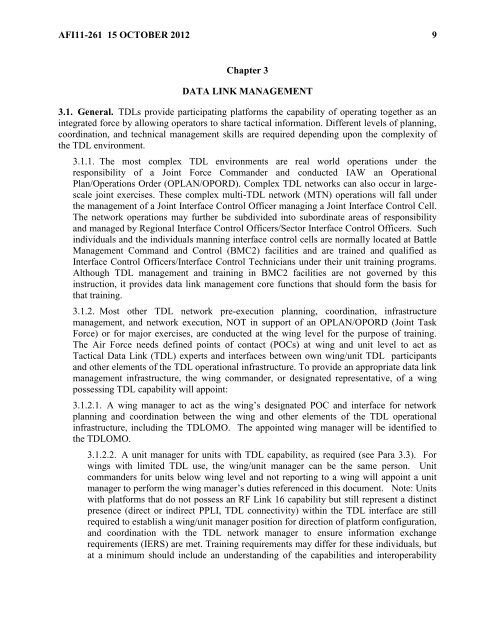By order of the air force instruction 11-261 - Air Force E-Publishing ...
By order of the air force instruction 11-261 - Air Force E-Publishing ...
By order of the air force instruction 11-261 - Air Force E-Publishing ...
Create successful ePaper yourself
Turn your PDF publications into a flip-book with our unique Google optimized e-Paper software.
AFI<strong>11</strong>-<strong>261</strong> 15 OCTOBER 2012 9<br />
Chapter 3<br />
DATA LINK MANAGEMENT<br />
3.1. General. TDLs provide participating platforms <strong>the</strong> capability <strong>of</strong> operating toge<strong>the</strong>r as an<br />
integrated <strong>force</strong> by allowing operators to share tactical information. Different levels <strong>of</strong> planning,<br />
coordination, and technical management skills are required depending upon <strong>the</strong> complexity <strong>of</strong><br />
<strong>the</strong> TDL environment.<br />
3.1.1. The most complex TDL environments are real world operations under <strong>the</strong><br />
responsibility <strong>of</strong> a Joint <strong>Force</strong> Commander and conducted IAW an Operational<br />
Plan/Operations Order (OPLAN/OPORD). Complex TDL networks can also occur in largescale<br />
joint exercises. These complex multi-TDL network (MTN) operations will fall under<br />
<strong>the</strong> management <strong>of</strong> a Joint Interface Control Officer managing a Joint Interface Control Cell.<br />
The network operations may fur<strong>the</strong>r be subdivided into subordinate areas <strong>of</strong> responsibility<br />
and managed by Regional Interface Control Officers/Sector Interface Control Officers. Such<br />
individuals and <strong>the</strong> individuals manning interface control cells are normally located at Battle<br />
Management Command and Control (BMC2) facilities and are trained and qualified as<br />
Interface Control Officers/Interface Control Technicians under <strong>the</strong>ir unit training programs.<br />
Although TDL management and training in BMC2 facilities are not governed by this<br />
<strong>instruction</strong>, it provides data link management core functions that should form <strong>the</strong> basis for<br />
that training.<br />
3.1.2. Most o<strong>the</strong>r TDL network pre-execution planning, coordination, infrastructure<br />
management, and network execution, NOT in support <strong>of</strong> an OPLAN/OPORD (Joint Task<br />
<strong>Force</strong>) or for major exercises, are conducted at <strong>the</strong> wing level for <strong>the</strong> purpose <strong>of</strong> training.<br />
The <strong>Air</strong> <strong>Force</strong> needs defined points <strong>of</strong> contact (POCs) at wing and unit level to act as<br />
Tactical Data Link (TDL) experts and interfaces between own wing/unit TDL participants<br />
and o<strong>the</strong>r elements <strong>of</strong> <strong>the</strong> TDL operational infrastructure. To provide an appropriate data link<br />
management infrastructure, <strong>the</strong> wing commander, or designated representative, <strong>of</strong> a wing<br />
possessing TDL capability will appoint:<br />
3.1.2.1. A wing manager to act as <strong>the</strong> wing’s designated POC and interface for network<br />
planning and coordination between <strong>the</strong> wing and o<strong>the</strong>r elements <strong>of</strong> <strong>the</strong> TDL operational<br />
infrastructure, including <strong>the</strong> TDLOMO. The appointed wing manager will be identified to<br />
<strong>the</strong> TDLOMO.<br />
3.1.2.2. A unit manager for units with TDL capability, as required (see Para 3.3). For<br />
wings with limited TDL use, <strong>the</strong> wing/unit manager can be <strong>the</strong> same person. Unit<br />
commanders for units below wing level and not reporting to a wing will appoint a unit<br />
manager to perform <strong>the</strong> wing manager’s duties referenced in this document. Note: Units<br />
with platforms that do not possess an RF Link 16 capability but still represent a distinct<br />
presence (direct or indirect PPLI, TDL connectivity) within <strong>the</strong> TDL interface are still<br />
required to establish a wing/unit manager position for direction <strong>of</strong> platform configuration,<br />
and coordination with <strong>the</strong> TDL network manager to ensure information exchange<br />
requirements (IERS) are met. Training requirements may differ for <strong>the</strong>se individuals, but<br />
at a minimum should include an understanding <strong>of</strong> <strong>the</strong> capabilities and interoperability
















